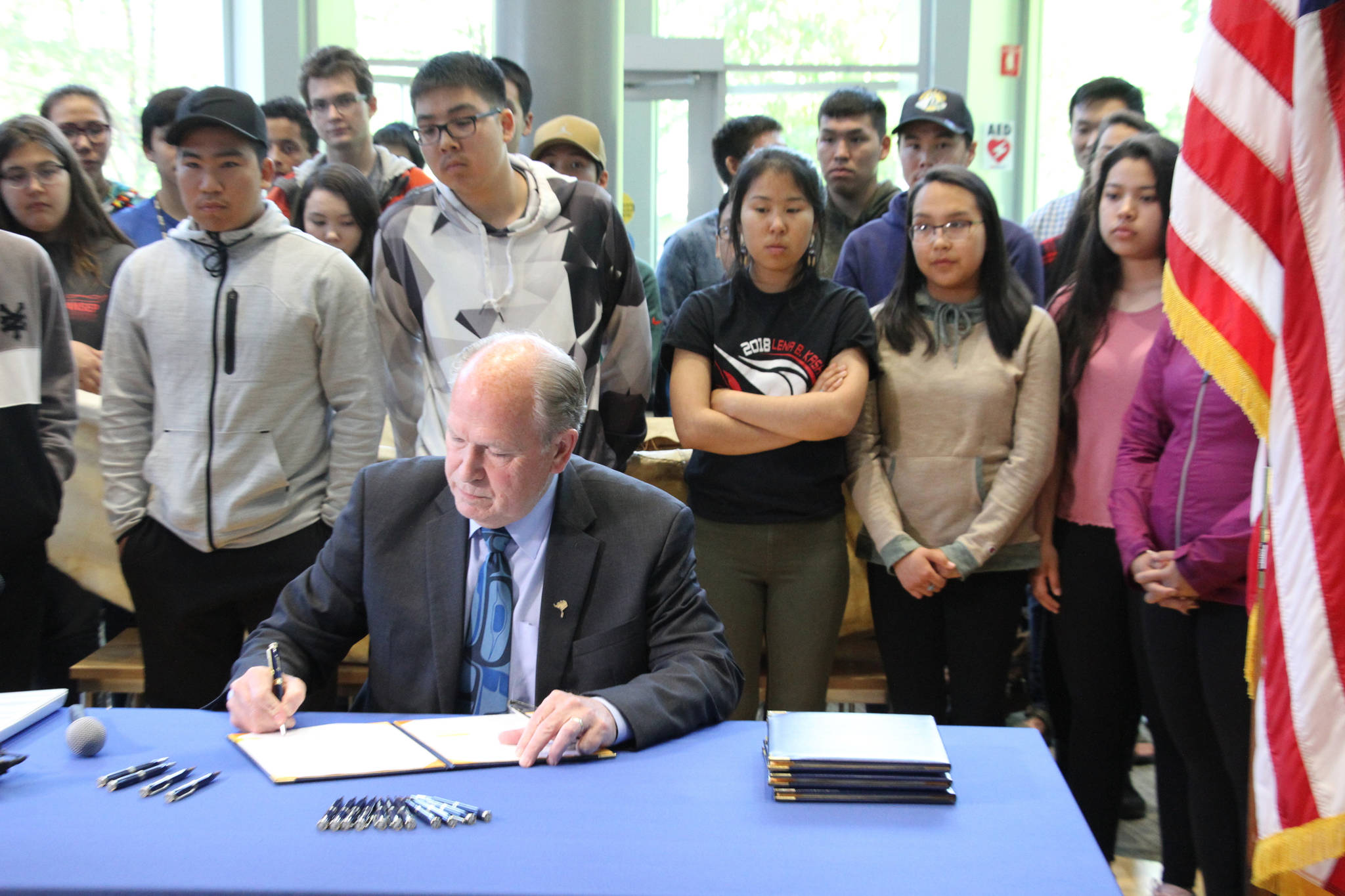On Wednesday in Anchorage, Gov. Bill Walker signed a $10.4 billion state operating budget, a $1.5 billion capital construction and renovation budget, a mental health treatment budget and a bill that includes a plan to spend from the Alaska Permanent Fund for the first time.
Walker vetoed fewer than a handful of projects from the budget, which covers the fiscal year starting July 1. Press releases from the governor’s office and various legislators noted that the budget and accompanying legislation will reduce Alaska’s annual deficit from almost $2.5 billion to $700 million.
What those releases neglect to mention is that this year’s state budget fails to address millions — and likely billions — of dollars in obligations the state must eventually pay. Some of those obligations are due as soon as next year, and some were even incurred in the process of writing this year’s budget. They effectively create a shadow deficit much larger than the one that is apparent on the books.
The size of that shadow deficit depends on a variety of factors, not all of which are known right now, and the smallest pieces of that shadow deficit are the ones most clearly defined.
The new budget, for example, deliberately underfunds the state’s Medicaid program. Federal law requires certain payments, and the Legislature failed to approve enough money to fully pay the bills.
In other cases, the Legislature paid for ongoing expenses from accounts that don’t recharge quickly. That money won’t be available next year, and the Legislature will be forced to find a new way to pay for those expenses.
“There is some shortage, no doubt about that,” said David Teal, director of the nonpartisan Legislative Finance Division.
A final report on the “holes,” as budgeters term them, won’t be available until August or September.
“I think it’ll be in the neighborhood of $100 million,” Teal said.
Pat Pitney, director of the state Office of Management and Budget, agreed with Teal’s estimate but said it could be larger if money diverted from completed projects is included.
“One hundred million, unless you count reappropriations, and then it’s closer to $150 million,” she said.
Later this month, the state’s actuaries are expected to release updated figures for the money required to meet the state’s ongoing retirement debt. Pitney anticipates an increase, which means payments for the state will rise.
A bigger portion of the shadow deficit comes from the debates over the size of the Permanent Fund Dividend. Various candidates for governor and the Legislature have called for a “full” dividend paid according to the traditional formula.
This year, lawmakers approved a lower dividend in order to partially balance the deficit. This year’s dividend of $1,600 per person will cost the state about $1.02 billion.
The traditional formula would have produced a dividend of about $2,650, according to calculations made by Anchorage economist Brad Keithley.
Adding an extra $1,000 to the dividend would cost about $630 million (a figure based upon an estimated number of people who receive dividends).
“If we honored the Permanent Fund Protection Act and paid a $2,650 dividend, our deficit would be $1.35 billion,” Pitney said.
An ongoing lawsuit against the state also threatens a plan to borrow up to $1 billion for tax credits owed to the oil and gas industry and spread that debt over time. If the plan blows up, the state will have to come up with hundreds of millions of dollars more quickly.
“That was a huge stabilizing impact on the budget, because we can set the payments,” Pitney said.
The next Legislature and whomever wins the race for governor this fall will also have to ask whether the state has cut its budget too far to provide basic services. In January, lawmakers were told the state has a $1.87 billion backlog when it comes to maintenance at state buildings. This year’s budget includes about $55 million for deferred maintenance — less than the amount of projects being added to the list this year.
“When you’re putting $50 (million) to $60 million into a $1.8 billion problem, you’re going to be falling behind,” Pitney said. “Deferred maintenance should be in the $100 million to $150 million range annually.”
In the longer term, the state must also figure out how to pay a multibillion-dollar deficit in its retirement system and meet the constitutional requirement to re-fill the Constitutional Budget Reserve, the savings account that the Legislature has used for the past several years to balance its books.
“We now owe roughly $15 billion to the CBR,” Teal said, but added that money can be repaid at any time without interest.
Compounding the problem is that the state is almost out of available reserves. With a $700 million deficit, the Constitutional Budget Reserve will last for only three more years. Increasing the take from the Alaska Permanent Fund would likely render it impermanent, according to estimates presented to both the Legislature and the fund’s board of trustees. (And even current spending levels may be too high for sustainability, according to some projections.)
Even within the shadow deficit, there are some rays of light. If oil prices stay high, the state’s $700 million annual deficit will be reduced or eliminated entirely. That won’t eliminate the long-term problems, but it does reduce issues in the short term.
• Contact reporter James Brooks at jbrooks@juneauempire.com or 523-2258.

